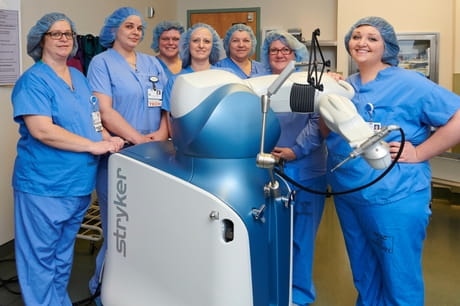How robotics is transforming joint replacement surgery
You’ve seen them in the movies and heard about it in the news—robots and artificial intelligence are helping people do their jobs better. While they don’t completely replace the need for traditional surgeries, these robots are now making their way onto the operating room floor, where they’re assisting surgeons and improving precision and accuracy during surgery. Robotics are quickly becoming a new tool in hospitals’ treatment arsenals.
“Robotics are improving the way doctors do surgery—including joint replacements,” said orthopedic surgeon Michael Suk, MD, chief physician officer at Geisinger. “But, some people are understandably not sure how to feel about robots performing surgeries. The thing to keep in mind is that the robots involved in surgery are not completely autonomous. They’re controlled by the doctor, which allows doctors to combine their knowledge and judgment with the precision and control of a robot. The robot isn’t doing the surgery—the doctor is, but with the help of the robot.”
Getting to know Mako
Mako is a robotic surgical arm that can perform partial or total hip replacements.
By using CT scan information, the system can create 3-D images of the joint and help doctors plan for the surgery. During the surgery, doctors can use Mako to prepare the bone, introduce the implant and ensure that it is balanced and fits well.
“In the same way that a doctor uses a surgical tool like a scalpel, doctors can use Mako,” said Dr. Suk. “Mako is a precision tool that allows doctors to perform minimally invasive surgeries—it doesn’t do the surgery by itself. It’s essentially an extension of the doctor.”
Mako is extremely precise—it allows doctors to do partial knee replacements two to three times more accurately than conventional partial knee replacements. Mako hip replacements are shown to be four times more accurate and reproducible than conventional hip replacements. This accuracy helps spare healthy bone and tissue while getting rid of diseased and problematic bone and tissue.
What Mako means for you
In the next decade, joint replacements are expected to become much more common. By 2030, experts anticipate a 673 percent increase in knee replacements and a 174 percent increase in hip replacements. Together with traditional joint replacement surgeries, Mako presents another opportunity for treating this increasingly common issue.
Mako has been shown to lead to higher patient satisfaction, lower costs in the long term and better outcomes. Because of the precision and attention to each individual’s anatomy, Mako can also cut down on the amount of healing and rehabilitation time.
“For most people, surgery with the Mako is very successful,” said Dr. Suk. “Because of how minimally invasive the procedure is and how well the implant is aligned and adjusted, most people are able to get back on their feet sooner than they would otherwise.”
Orthopedic surgeon Michael Suk, MD, is Geisinger’s chief physician officer and chair of the Geisinger Musculoskeletal Institute. Geisinger Community Medical Center, Geisinger South Wilkes-Barre and Geisinger Shamokin Area Community Hospital are the only hospitals in northeastern and central Pennsylvania to offer patients robotic-arm assisted knee and hip replacements with the Mako System. For more information, call 800-275-6401 or email FixMyJoints@geisinger.edu.



